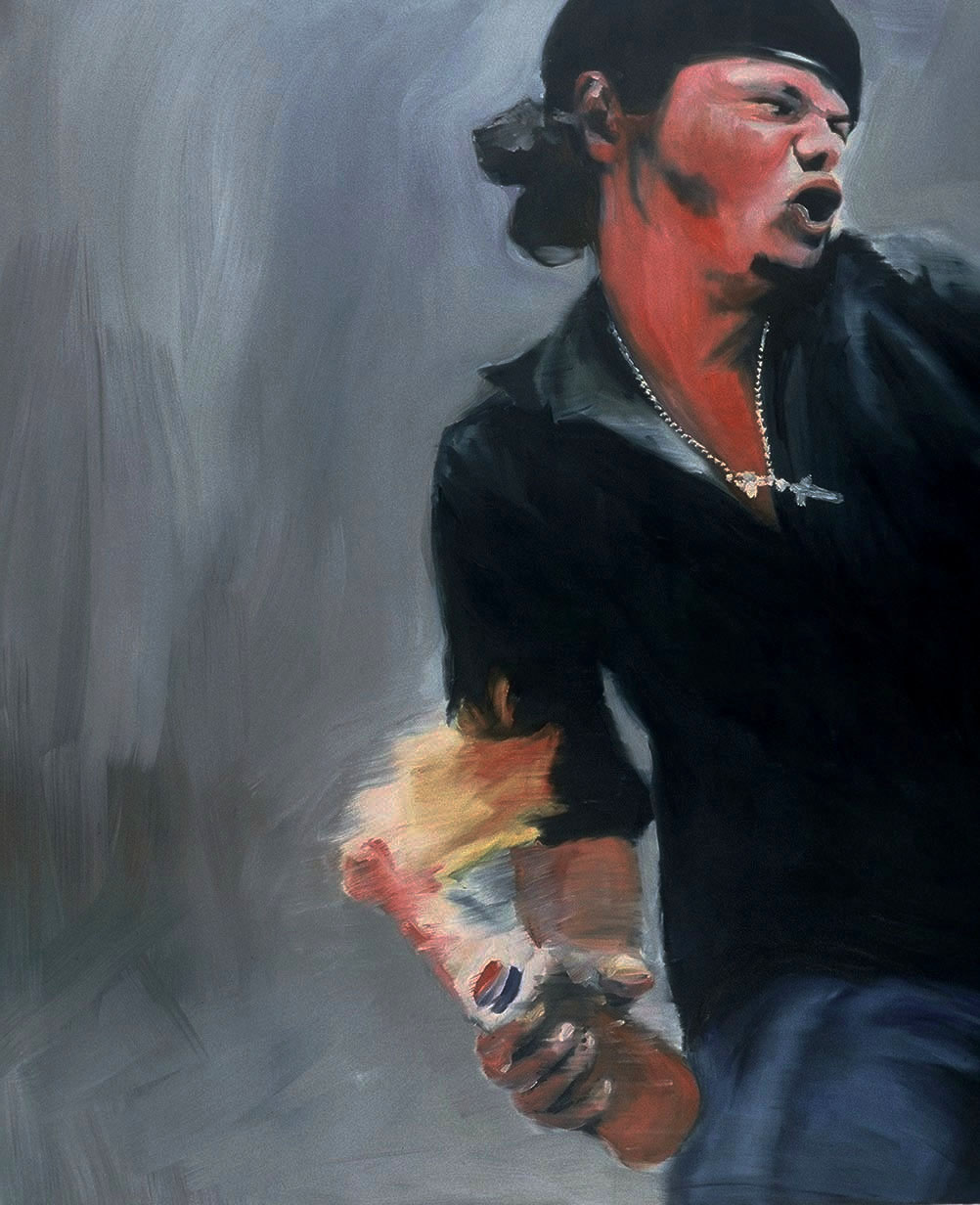Censorship comes in many different forms. My first taste of it came in the spring of 2004, in the shape of a cease-and-desist letter, concerning a painting I exhibited in my recent solo show. Like all of my work, the painting referred to a photograph: in this case, a JPEG I had found online that depicted a man throwing a Molotov cocktail. As I have done with countless other found photos, I used this image as a stepping-stone in the service of making my work.
Some readers may be familiar with the story: The cease-and-desist letter informed me that the JPEG was part of a photograph shot thirty years earlier by the photojournalist Susan Meiselas; it was the centerpiece of her photo essay covering the revolution in Nicaragua.
Furthermore, the letter explained, I had infringed upon the photographer’s copyright; by creating my painting, I was “sailing under the flag of piracy.” Apparently, Susan Meiselas was not happy with the way I recontextualized her photograph. She opted to gain control of my painting through legal means, including the exhibition rights and all reproductions.
Feeling intimidated, I removed the image of the painting from my website. But when I refused to sign away my copyright as the letter demanded, I received a subsequent letter that threatened legal action and a fine. That’s when an online protest was launched on my behalf. The image of my painting went viral, and the legal method so commonly employed to bury unwanted speech backfired, to great fanfare.
But what if it hadn’t? Like so many artists, I would have been forced to back down or hold my ground against aggressive legal action. To compound the dilemma, I didn’t know what my rights were under the law.
Back in 2004, as an artist interested in the world of new technologies, I had a sense of the changing terrain brought on by the popularization of remix culture. I read about Napster and disputes over music file sharing, and I participated in discussions about shifts in conventions of copying and sharing. But like many artists, I had only a vague understanding of the legal ramifications for my work, and I hadn’t yet explored the grey areas surrounding copyright and fair use. As an artist creating one-of-a-kind paintings, as opposed to infinitely reproducible digital artworks, I never dreamed that this problem would arrive with such force on my doorstep.
Again, like so many artists, I was unprepared for the controversy, one that threatened my ability to show my work and reproduce it on my website; the implications for how I might be able—or unable—to express myself freely in the future were stark. Lacking knowledge of my legal rights, I had few tools with which to articulate my position and defend it.
Of course, the improper leveraging of copyright law is only one example of the many instances in which censorship may occur. Most artists don’t see the threat of censorship coming; they remain unaware of the unintended controversy their work may engender until after the fact. Those artists who aim to be provocative may be ill equipped to handle threats of censorship if and when they occur. Other artists, feeling vulnerable in an openly hostile environment, preemptively censor their work to avoid possible repercussions.
Unsure of our rights, we artists are easy targets for indiscriminate or illegal censorship. Whatever the situation, rare is the artist who is well informed about her rights and ready to navigate threats of censorship when they come—and chances are, they will come.
What is to be done?
Enter Artist Rights, a collaboration between the National Coalition Against Censorship’s Arts Advocacy Program and the Center for Democracy and Technology, which answers many questions that artists may have about their rights under the First Amendment, in clear, accessible language. The Artist Rights website is organized into four themes, covering different censorship issues:
- protected vs. unprotected speech
- speech regulated for its content or viewpoint
- contracts
- copyright and fair use
The site offers answers to many questions that artists may ask, such as: When does art about sexuality become obscenity? To what extent can the police and other authorities regulate my presence? Does my work fall within the bounds of fair use? In addition, relevant legal cases are summarized for nonspecialist readers. The site’s glossary presents legal terminology that may be encountered on the website and elsewhere, to clarify the concepts of censorship to laypeople.
Last, but not least, the website includes a contact form for artists who have questions or who need help with impending censorship threats or censorship that has already occurred.
I sometimes wonder how I might have responded to my cease-and-desist-letter had I known my rights. At the very least, I would have felt less vulnerable, and I would have been less dependent on my lawyer (who, fortunately for me, was wonderful and gave exemplary advice). I don’t have any regrets about my decisions, but if I had felt less cowed and more ready to discuss the situation on my terms, it would have made an enormous difference to me. So, to promote informed decision-making, I encourage artists to learn about their legal rights. Use the Artist Rights site; contact the NCAC’s Arts Advocacy Program to ask questions or to request assistance and support. There’s no need to venture blindly into a censorious war zone, or needlessly self-censor, out of fear.
Editor’s note: Joy Garnett is the Arts Advocacy Program Associate at the National Coalition Against Censorship, New York.





Pingback: Artists Know Your Rights, An Interview About NCAC's Latest Resource - WorkPuppy.com